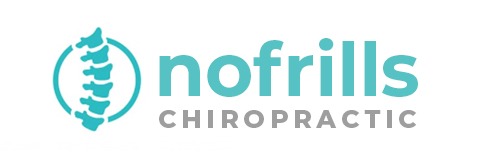Relieve Lower Back Pain with Expert Chiropractic Care
Experiencing a dull, persistent ache on your lower back? Read on and discover lower back pain management with chiropractic adjustments and other techniques.

About Lower Back Pain
CONTRIBUTORS TO LOWER BACK PAIN
What factors contribute to lower back pain?
Dull aches
Sharp or shooting pain
Muscle spasms
Numbness or tingling
Limited range of motion
Chronic pain
It’s crucial to note that lower back pain symptoms can vary based on the cause and individual circumstances. Seeking guidance from a healthcare professional is essential for an accurate diagnosis and an appropriate care plan, particularly when faced with persistent or severe symptoms.
Dull ache
A persistent, low-level discomfort or ache in the lower back is a prevalent symptom of mild to moderate lower back pain. It can range from mild to moderately painful, occurring continuously or intermittently.
Sharp or shooting pain
Linked with acute lower back pain, sudden, intense pains may be triggered by specific movements or positions, often radiating down the leg—a potential indicator of conditions like sciatica.
Stiffness
Challenges in movement due to lower back stiffness may result from muscle tension or inflammatory conditions, particularly noticeable in the morning or after prolonged inactivity.
Muscle spasms
Involuntary contractions of lower back muscles, known as muscle spasms, can be painful and limiting. They frequently serve as a protective response to injury or strain.
Numbness or tingling
Lower back pain may coincide with sensations of numbness, tingling, or pins-and-needles in the lower back, buttocks, or legs, especially when nerve compression is involved.
Limited range of motion
Pain and stiffness may hinder bending, twisting, or other lower back movements, indicating the presence of lower back pain.
Chronic pain
Persistent lower back pain lasting three months or more is considered chronic. It may have underlying causes such as degenerative conditions or ongoing inflammation.
STOP LOWER BACK PAIN
How do I alleviate my lower back pain?
Rest
In some cases, the simplest solution can be the most effective.
If you’ve recently strained your back or are experiencing acute pain, allowing your body adequate time to rest and heal is crucial.
However, it’s important to strike a balance, as excessive inactivity may weaken your muscles and lead to prolonged pain.
Heat & cold therapy
Quick relief for lower back pain can be found by applying heat or cold.
Cold packs aid in reducing inflammation and numbing the area, while heat packs or warm baths relax tight muscles.
Experimenting with both methods can help identify what works best for your specific situation
Stretch & Strengthening
Stretching and strengthening exercises (e.g. bridge exercise, hamstring, side planks) can indeed help alleviate lower back pain by improving flexibility, stability, and muscle support.
Remember to listen to your body and avoid overstretching or pushing through pain.
Do consult a healthcare professional before any new exercise routines.
Massage
A soothing massage can bring relief by releasing tension in muscles and enhancing blood flow to the affected area.
Whether it’s a professional massage or a gentle self-massage with a foam roller, hands-on techniques can effectively address back pain.
Ergonomic changes
If prolonged sitting is linked to your lower back pain, consider making ergonomic adjustments to your workspace. Modify your chair, desk, and computer setup to ensure proper posture and back support.
Take regular breaks to stand, stretch, and walk around.
Chiropractic care
Chiropractic care encompasses spinal and joint manipulation to alleviate pain and enhance overall health.
Numerous individuals experiencing lower back pain have reported substantial relief through chiropractic adjustments.
Acupuncture
Acupuncture, an alternative therapy involving the insertion of fine needles into specific body points, is known to alleviate pain and facilitate healing.
Many individuals find relief from lower back pain through acupuncture sessions.
Posture correction
Poor posture often plays a role in lower back pain. Mindful awareness of your posture while sitting, standing, or walking is essential.
Cultivate good posture by keeping your spine in a neutral, natural position, and use supportive chairs and cushions as needed.
Rest
In some cases, the simplest solution can be the most effective. If you’ve recently strained your back or are experiencing acute pain, allowing your body adequate time to rest and heal is crucial. However, it’s important to strike a balance, as excessive inactivity may weaken your muscles and lead to prolonged pain.
Heat and cold therapy
Quick relief for lower back pain can be found by applying heat or cold. Cold packs aid in reducing inflammation and numbing the area, while heat packs or warm baths relax tight muscles. Experimenting with both methods can help identify what works best for your specific situation
Stretching and strengthening
Stretching and strengthening exercises (e.g. bridge exercise, hamstring, side planks) can indeed help alleviate lower back pain by improving flexibility, stability, and muscle support.
Remember to listen to your body and avoid overstretching or pushing through pain.
Do consult a healthcare professional before any new exercise routines.
Ergonomic changes
If prolonged sitting is linked to your lower back pain, consider making ergonomic adjustments to your workspace. Modify your chair, desk, and computer setup to ensure proper posture and back support. Take regular breaks to stand, stretch, and walk around.
Posture correction
Poor posture often plays a role in lower back pain. Mindful awareness of your posture while sitting, standing, or walking is essential. Cultivate good posture by keeping your spine in a neutral, natural position, and use supportive chairs and cushions as needed.
Massage
A soothing massage can bring relief by releasing tension in muscles and enhancing blood flow to the affected area. Whether it’s a professional massage or a gentle self-massage with a foam roller, hands-on techniques can effectively address back pain.
Acupuncture
Acupuncture, an alternative therapy involving the insertion of fine needles into specific body points, is known to alleviate pain and facilitate healing. Many individuals find relief from lower back pain through acupuncture sessions.
Chiropractic care
Chiropractic care encompasses spinal and joint manipulation to alleviate pain and enhance overall health. Numerous individuals experiencing lower back pain have reported substantial relief through chiropractic adjustments.
UNDERSTANDING LOWER BACK PAIN
What are the common indicators of lower back pain?
Lower back pain is characterized by discomfort or pain in the region beneath the ribcage and above the hips, known as the lumbar spine. Comprising five vertebrae (L1 to L5), this area bears much of the body’s weight and facilitates various movements.
Lower back pain may present as a mild, enduring ache or an intense, sharp discomfort, classified as either acute (lasting a few days to weeks) or chronic (extending beyond three months).
Typical symptoms include:
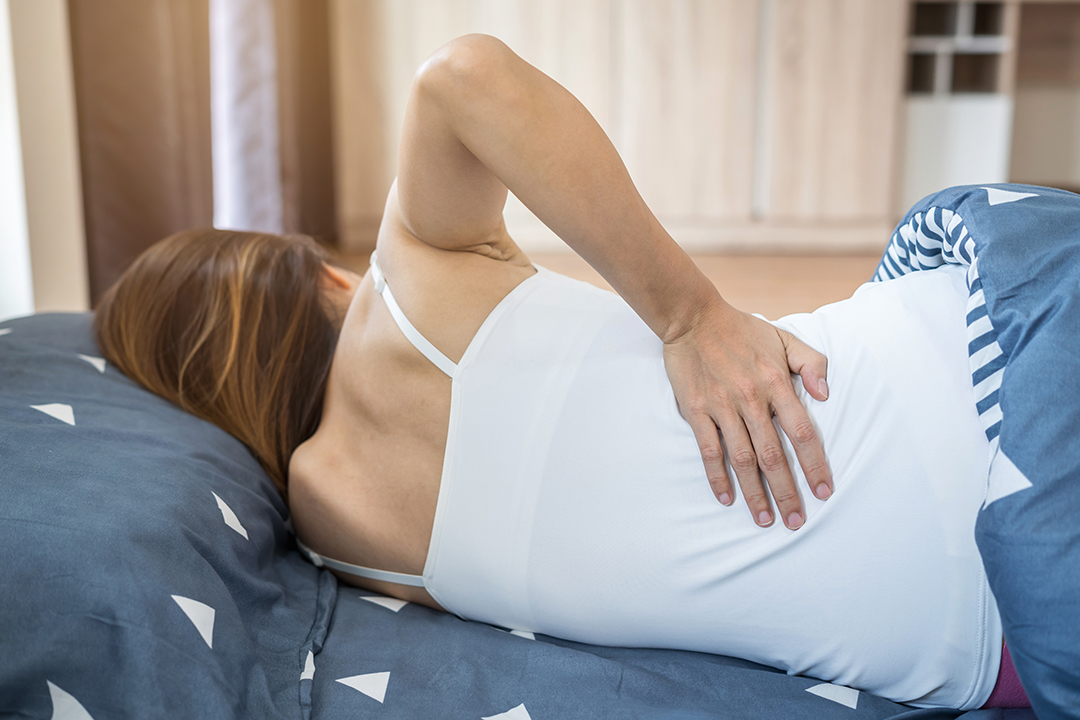
Pregnancy Related
Pregnancy, while a beautiful journey, often comes with discomfort, including lower back pain. The additional weight and altered body posture during pregnancy contribute to increased strain on the lumbar region. Hormonal shifts further loosen ligaments, introducing instability in the lower back.
Prolonged Standing
Conversely, extended periods of standing can also exert pressure on the lower back. Occupations requiring prolonged standing may lead to pain, given the continuous stress on the lumbar region. Additionally, poor standing posture can exacerbate the issue.
Prolonged Sitting
In our modern, technology-driven era, many individuals spend prolonged hours seated – whether at a desk, in front of a computer, or during extended commutes. Persistent sitting places strain on the lower back, leading to discomfort. The lack of movement weakens muscles over time, potentially resulting in persistent pain.
Incorrect Sleeping Posture
LOWER BACK PAIN FROM BENDING OVER
What causes lower back pain during bending over?
Lower back pain triggered by bending over can be influenced by various factors.
Here are several key considerations:
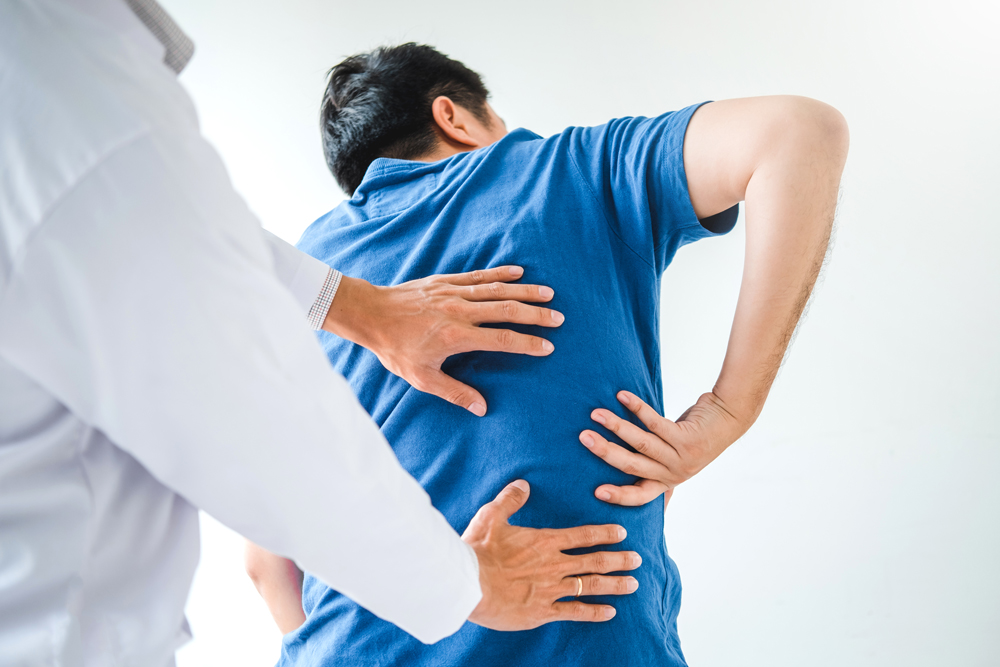
Muscle Spasms
Dehydration, insufficient blood flow, nerve compression, and muscle overuse can induce muscle spasms, contributing to lower back discomfort when bending over or lifting objects.
Muscle Strain
Sudden or forceful bending movements, especially without proper preparation, can strain the muscles in the lower back, resulting in pain and discomfort.
Spondylolisthesis
Degenerative conditions
Bending over may worsen symptoms of degenerative conditions like osteoarthritis or spinal stenosis, contributing to lower back pain.
Poor posture
Arthritis
Herniated discs
Bending over places pressure on inter-vertebral discs, and if one of these discs herniates or ruptures, it may compress nearby nerves, causing sharp, shooting pain in the lower back.
CHIROPRACTIC APPROACHES TO LOWER BACK PAIN
Should I see a chiropractor for lower back pain?
Chiropractic care stands as a viable choice for those seeking non-medication approaches to address lower back pain. Chiropractors, specialized healthcare professionals, excel in diagnosing and treating musculoskeletal conditions, including issues related to the lower back. Through hands-on techniques, they perform adjustments on the spine and other joints, aiming to relieve pain and enhance overall spinal health.
If you’re grappling with chronic or recurring lower back pain, seeking the expertise of a chiropractor can prove beneficial. Chiropractic care is known to address various lower back issues, encompassing muscle strains, herniated discs, and misaligned vertebrae. The focus of chiropractors lies in identifying the root cause of your pain and delivering precise adjustments to tackle it.
How many chiropractic sessions are necessary in order to resolve lower back pain?
The number of chiropractic sessions required to address lower back pain can vary, influenced by factors like the severity and underlying cause of your pain. Generally, chiropractic treatment plans involve an initial phase of more frequent sessions, succeeded by a maintenance phase.
The breakdown is as follows:
Initial phase
In the initial stage of chiropractic care, you may need to attend 2-3 sessions per week for several weeks. The primary objective is to alleviate pain, restore proper spinal alignment, and enhance overall function. The frequency and duration of sessions depend on your specific condition and your body’s response to treatment.
Recovery phase
As your pain and symptoms show improvement, the frequency of chiropractic visits typically decreases. During this recovery phase, you may visit once a week or once every two weeks.
Maintenance phase
Once your lower back pain is effectively managed, your chiropractor might recommend occasional visits for maintenance. These visits play a preventive role, helping ward off potential future issues and maintaining the health of your spine. Depending on your individual needs, you might see your chiropractor once a month or less frequently.
It’s essential to recognize that chiropractic care often yields optimal results when combined with additional self-care strategies, such as regular exercise, stretching routines, and maintaining good posture.
For optimal results, chiropractic care should be combined with self-care strategies like regular exercise, stretching, and maintaining good posture. This holistic approach enhances the effectiveness of chiropractic treatments for better overall health.
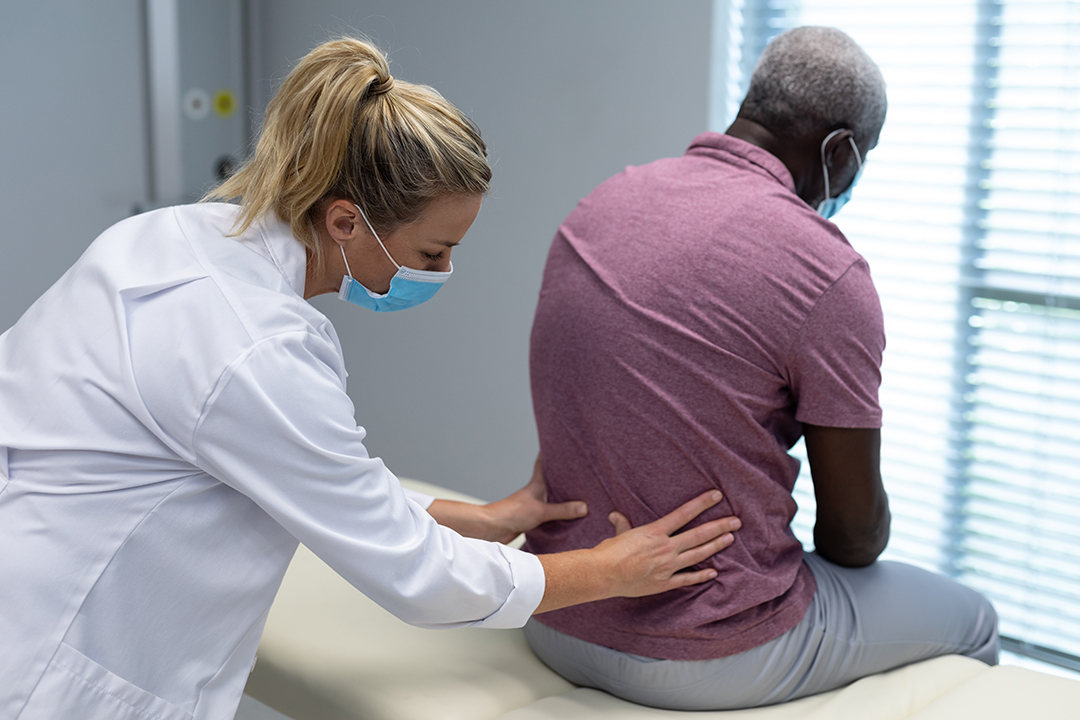
CHIROPRACTIC SOLUTIONS
Chiropractic techniques for lower back pain relief
Chiropractors utilize various chiropractic adjustment techniques to effectively manage lower back pain and enhance spinal health. Discover some of the most common chiropractic techniques used for lower back pain relief:
Spinal Manupilation
The spinal manipulation technique is the most well-known chiropractic method. It involves the chiropractor using their hands to apply controlled force to specific spinal joints. This technique aims to restore proper alignment, reduce pain, and improve overall spinal function.
Activator Technique
The Activator Method employs a handheld instrument to deliver precise, gentle impulses for spinal adjustments. This technique is ideal for those who require or prefer a softer approach to chiropractic care.
Sacro-Occipital Technique (SOT):
SOT focuses on the connection between the sacrum (the triangular bone at the base of the spine) and the skull, utilizing gentle, low-force methods to restore spinal balance and alignment.
Flexion-Distraction Technique
This chiropractic technique involves using a specially designed table to gently traction the spine, making it highly effective for treating conditions such as disc herniations and spinal stenosis.
The Gonstead Technique
It’s important to have an initial consultation with a chiropractor to determine the most appropriate technique for your specific condition. Chiropractors tailor their approach to the individual, taking into account your medical history, current symptoms, and any existing conditions.
Important: The information provided above is not a substitute for professional medical advice, diagnosis, or treatment. Since symptoms and treatments can vary for each individual, it is essential to consult a chiropractor or medical professional for a precise diagnosis and personalized treatment plan.
SLEEPING POSTURE MATTERS
Best sleeping positions to relieve lower back pain
Quality sleep is essential for your body’s healing and repair processes. Finding the optimal sleeping position can significantly reduce stress on your lower back.
Explore these recommended sleeping positions to alleviate lower back pain:
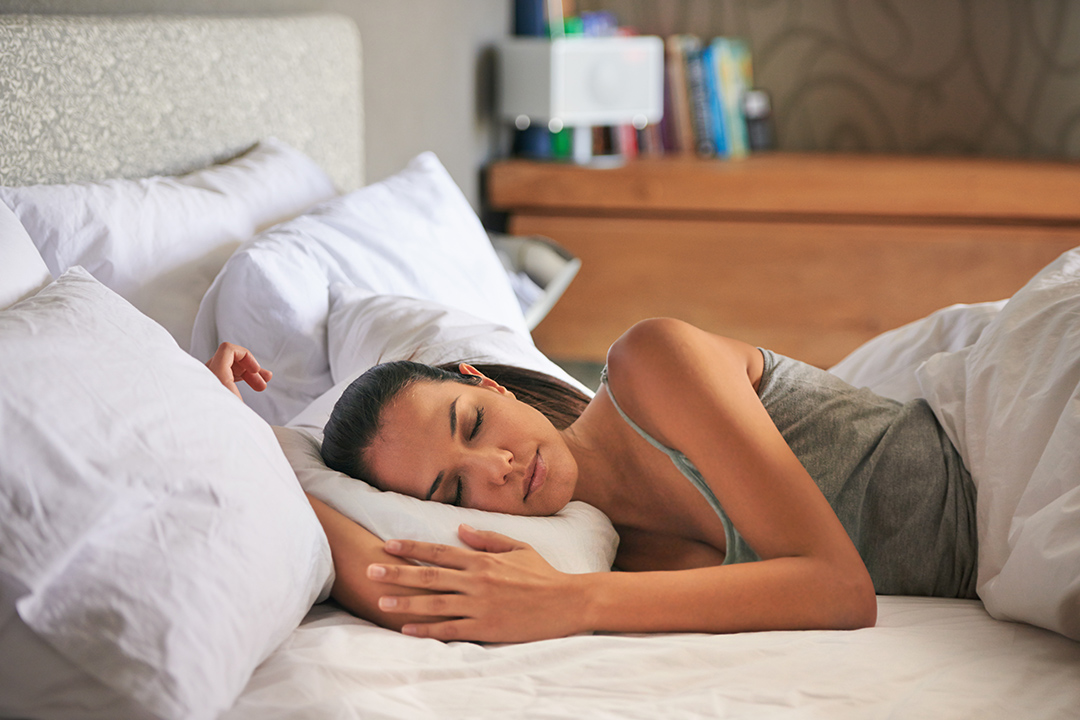
Lie on back + Pillow under knees
Lie on your back with a pillow under your knees to maintain the natural curve of your spine and support your lower back. This position helps alleviate pressure on your lumbar region, providing effective lower back pain relief.
Fetal position + Pillow between knees
Curling up in the fetal position can provide comfort for many individuals. To avoid excessive twisting of the spine, place a pillow between your knees.
Side sleep + Bent knees
Sleeping on your side with slightly bent knees can be comfortable. Draw your knees towards your chest and keep your spine neutral. Using a supportive pillow will help maintain proper alignment.
Stomach Sleeping
EXERCISES FOR LOWER BACK PAIN
Which exercises and stretches can alleviate lower back pain?
Consistent exercise and stretching are crucial for managing and preventing lower back pain. Here are some beneficial exercises and stretches to consider:

Partial Crunches for Core Strength
Lie on your back with your knees bent and hands placed behind your head. Lift your shoulders off the floor by engaging your abdominal muscles, being careful not to strain your neck. This exercise strengthens your core muscles, which can provide better support for your lower back.
Knee-to-Chest Stretch for Lower Back Relief
Lie flat on your back with your legs extended. Slowly bring one knee up to your chest while keeping the other leg straight on the floor. Hold the stretch for 20–30 seconds to effectively stretch and loosen lower back muscles, then switch sides. This exercise helps alleviate lower back pain and improve flexibility.
Pelvic Tilts for Lower Back Flexibility
Lie on your back with your knees bent and feet flat on the floor. Slowly tilt your pelvis up and down to engage your core muscles. This exercise promotes lower back flexibility and helps reduce stiffness.
Child's Pose for Lower Back Relief
Sit back on your heels with your knees apart, then lean forward and extend your arms in front of you. This stretch lengthens the lower back and relieves tension, providing effective pain relief and relaxation.
Cat-Cow Stretch for Spine Flexibility
Begin on your hands and knees, arching your back upwards like a cat, then smoothly transition to arching it downwards like a cow. This dynamic stretch enhances spine flexibility and mobility, promoting overall back health.
Bridge Exercise
Lie on your back with your knees bent and feet flat on the floor. Raise your hips to form a straight line from your shoulders to your knees. This exercise helps strengthen your glutes and lower back muscles.
Book your initial chiropractic visit
hello@nofrillschiropractic.com
Phone
9007 1085
Open Hours
Mondays - Sundays: 9am-6pm
We're here whenever you need us
hello@nofrillschiropractic.com
Contact Us
9007 1085
Open Hours
Monday-Sundays:
10am to 7pm
Address
279 Tanjong Katong Rd
S437062
